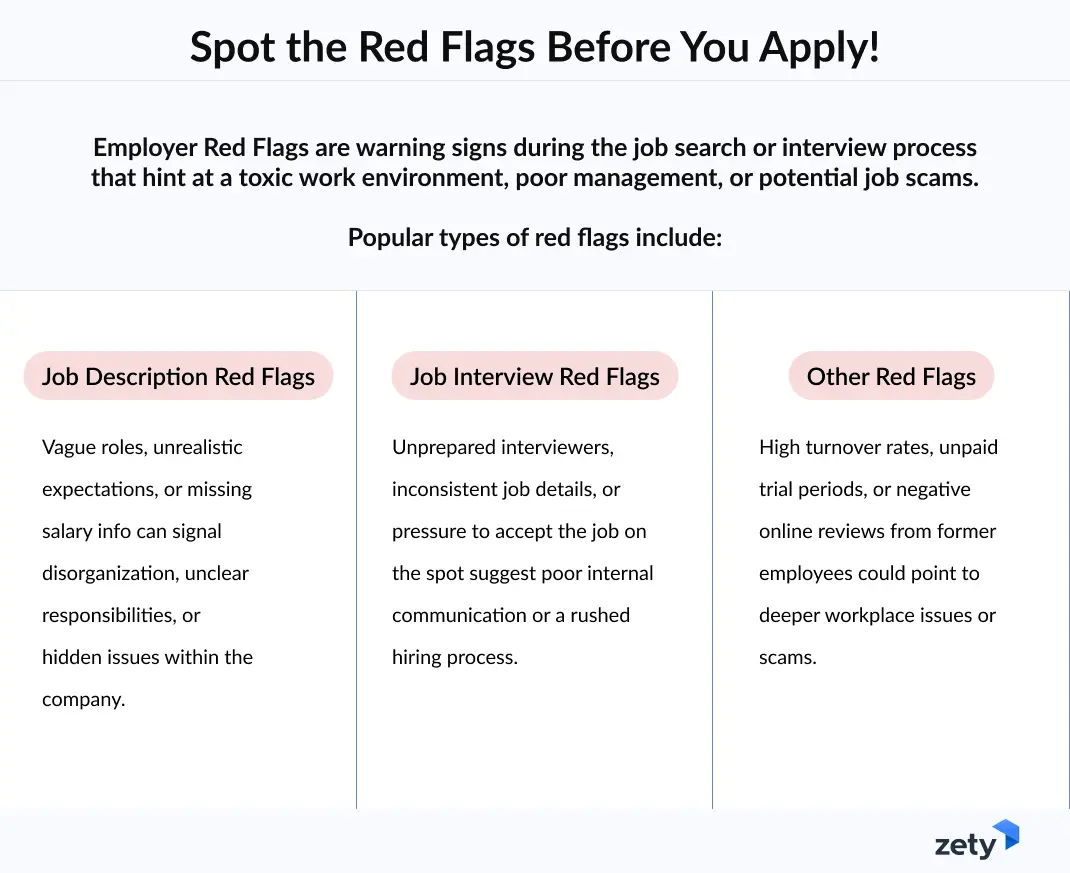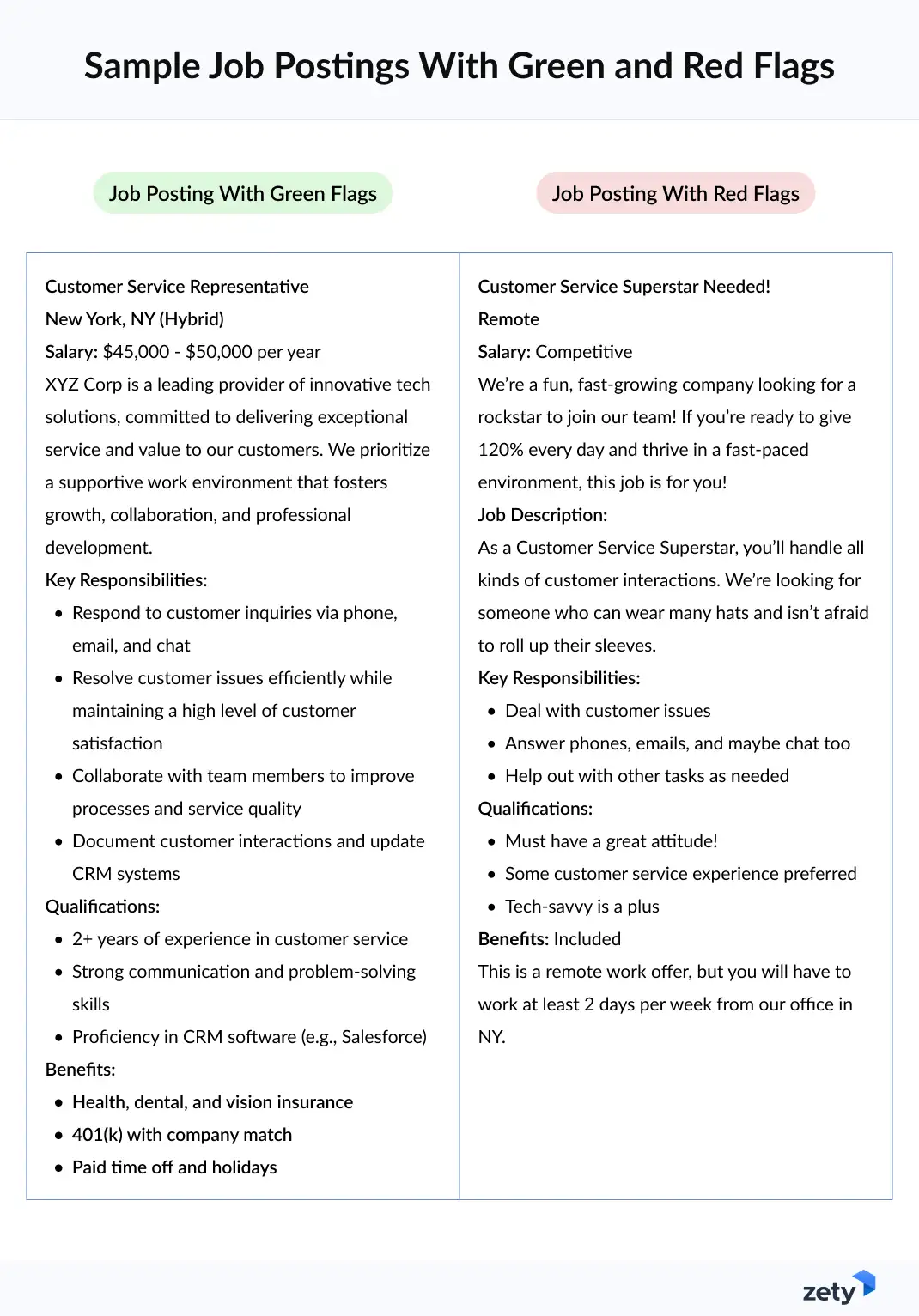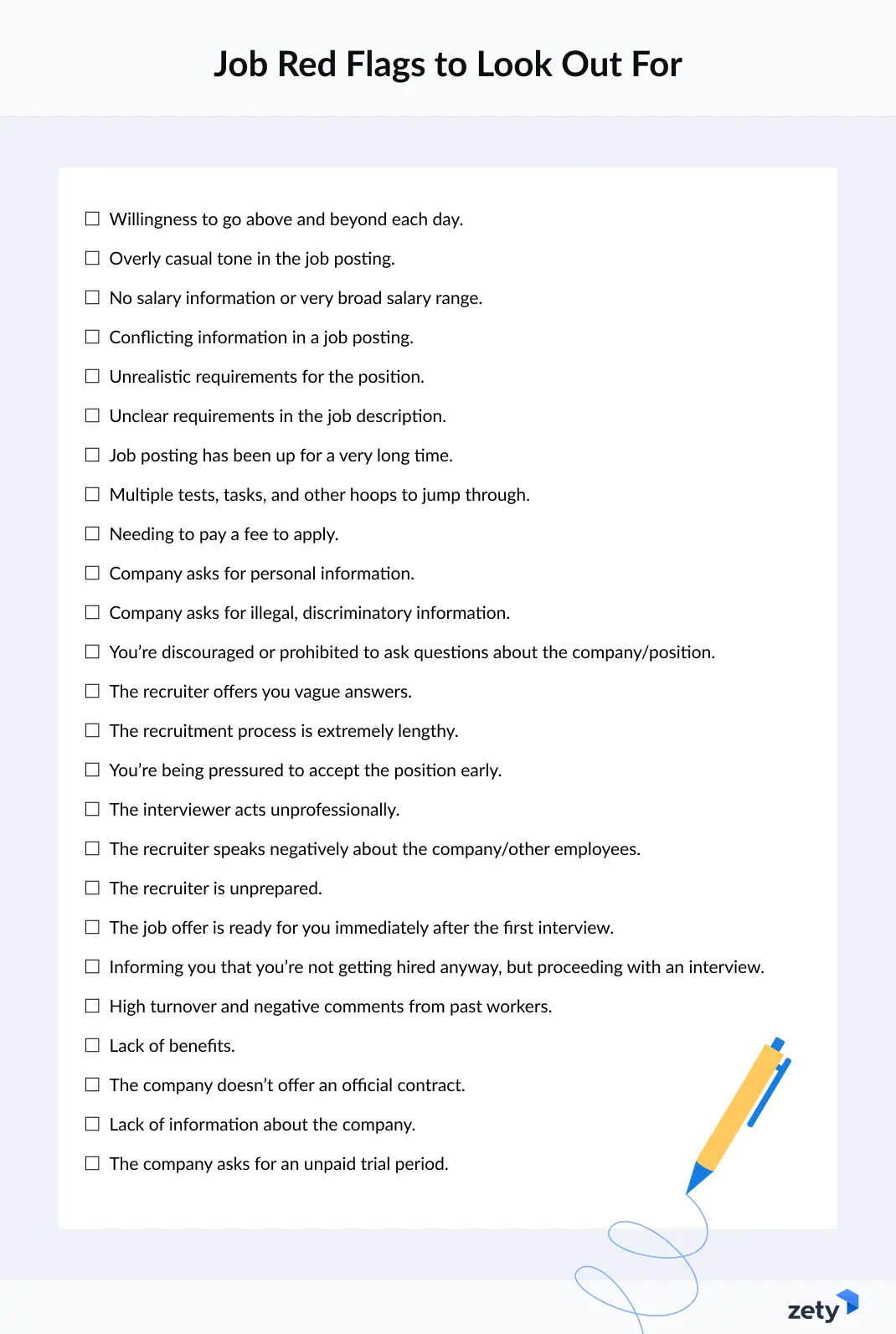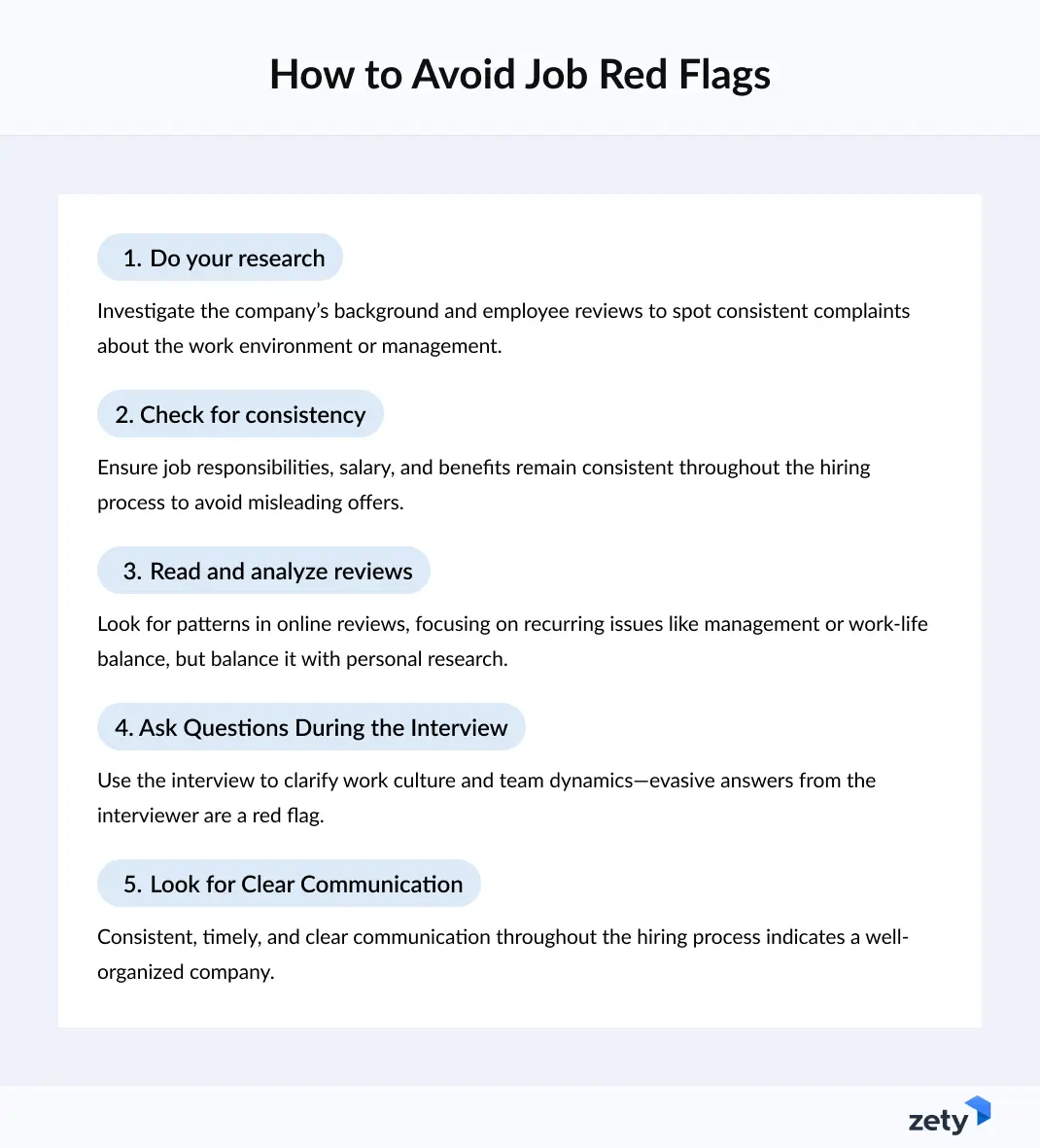25+ Employer Red Flags You Need to Know
Create Your Resume NowFinding the perfect job isn’t just about the salary, benefits, or even the job title. It’s also about ensuring the company you’re considering is a healthy, supportive environment where you can thrive, grow, and rest easy knowing you have career stability. Unfortunately, job scams and toxic workplaces are more common than you might think, and spotting them early can save you from stress and frustration.
Whether it’s vague job descriptions, high turnover rates, or unrealistic expectations, some signs can help you steer clear of problematic employers. Recognizing these employer red flags can make the difference between landing your dream job and getting stuck in an unprofessional nightmare.
What Are Employer Red Flags?
Employer red flags are warning signs that pop up in your brain during the job search or interview process, indicating that something might not be quite right with a potential employer. These red flags can help you gauge whether a company might be a good fit for you—or if it’s better to steer clear.
For instance, if you notice that the job posting has been up forever or that the company is super vague about the role and expectations, that’s a red flag. It might mean they have a high turnover or are just not organized. If the interviewer is unprepared or pressures you to accept the job on the spot, that’s another signal to pause and think things over. It’s also worth being cautious if the company asks for personal information too early or mentions unpaid trial periods—those can be signs of unprofessional or even shady practices.
Employer red flags are your gut-check moments. They’re the things that make you stop and wonder if this job is really what you’re looking for. It’s important to trust your instincts and do your homework before you commit. After all, you want to find a place where you’ll be happy, respected, and able to grow. If something feels off, it’s totally okay to keep looking until you find the right fit!

Do You Really Have to Watch Out for Red Flags?
Job scams and toxic workplaces are more common than you might realize. According to the Federal Trade Commission, overall reported losses from job scams tripled from 2020 to 2023, and in just the first six months of 2024, Americans lost more than $220 million to these scams. Notably, task scams alone accounted for nearly 40% of job scam reports in 2024, targeting unsuspecting job seekers with fake offers and fraudulent tasks.
On top of that, studies show that around 60% of employees have experienced a toxic work environment at some point in their careers. Toxic workplaces can lead to burnout, high turnover rates, and even mental health issues. Recognizing red flags early in the job search process can help you avoid falling into these traps and protect your career in the long run.
So, if you’re wondering whether it’s worth paying attention to those little warning signs—the answer is a resounding yes.
But, if you have no idea what to look out for, your spider senses might be off, and soon you may find yourself in a pickle. To avoid such situations, check out these common employer red flags:
Common Employer Red Flags in Job Descriptions
1. Willingness to Give 120% Every Day
Terms like fast-paced culture or suggestions that you must be willing to go above and beyond each day are potential red flags. For way too many employers, this translates to: “We expect you to put in overtime, and there will be a ton of pressure on you to complete all the designated tasks.”
When your whole job feels like working through an emergency day by day, it’s easy to feel overwhelmed and burned out. This, in turn, means lower efficiency and higher stress levels.
2. Overly Casual Tone
What’s the worst-sounding job description you’ve ever heard? For me, it’s “We’re looking for a cheerful monkey to join our monkey family. If you’re as determined as a chimpanzee reaching for a banana, you’ll fit right in.”
If a posting sounds like that, do you think the company is serious about your role? Overly casual language also often leads to ambiguity. If a job posting is too informal, it might not clearly convey what the job entails, what the company expects from you, or how performance will be measured.
3. No Salary Information or Too Broad a Range
When a job posting does not include salary information, it can indicate a lack of transparency from the employer. It’s also a waste of time and resources for both the candidate and the recruiting team, as without salary information, candidates may go through multiple stages of the application process only to find out that the offered salary does not meet their needs or expectations.
So, why do companies do that? Sneaky employers may omit salary details to attract a wider range of applicants and then offer a lower-than-expected salary. This tactic can be used to find someone willing to work for less than what the job should rightfully pay. Some states, like California or Rhode Island, have salary range transparency laws that require employers to post salary ranges in job advertisements. This, however, isn’t true for all states and other countries.
And yes—this red flag includes the popular phrase “Competitive salary.”
4. Conflicting Information
Conflicting information in a job posting can be a significant job red flag, indicating potential issues with the employer's communication, organization, or honesty. Inconsistent information may suggest that the company is disorganized or lacks a cohesive hiring process. This could signify broader operational issues within the organization, which might affect your potential work environment and job stability.
The most popular type of this employer red flag is putting up a posting for a remote job and later specifying that it’s a hybrid work model.
5. Unrealistic Requirements
Requiring extensive experience or highly specialized skills for an entry-level job can discourage many capable candidates from applying. The employer can miss out on talented individuals who could excel in the role with some training and development.
Furthermore, employers who ask for excessive qualifications for entry-level roles may be experiencing high turnover and looking to overqualified candidates in hopes of finding a quick fix. This may also signal that the employer is not willing to invest in training and development.
6. Unclear Job Description
Who hasn’t read a job posting in their life and stopped to think, “So what is this job about?” An unclear job description makes it hard for you to determine whether you are a good fit for the role. Without specific information about the job duties, it’s difficult to match professional skills and relevant experiences to the position.
This may also indicate a lack of organization within the company. Or, even worse, it may indicate that the employer will assign you tasks that normally would fall outside the scope of your job.
7. Job Posting Has Been Up for a Long Time
Have you ever heard of the term “ghost job”? It’s what we call a posting for a position that either doesn't exist or has already been filled. There are many reasons a company would post a ghost job. Some common ones are:
- Inflate internal hiring statistics.
- Make current employees believe that the company is growing and looking for extra help.
- Fulfill HR quotas.
- Gather promising resumes for future hiring for this position.
But that’s not even the worst potential job-searching red flag. Because it’s so easy to set up a job posting, even for a non-existent company, some of these postings are there just to gather your personal data.
8. Multiple Hoops to Jump Through
How many useless IQ tests did you do to not even get a response during your last job search? How often were you asked to select 20 personal qualities from a list of 100+ that describe you best? And how many tasks or tests did you have to do?
Doing all of these takes a ton of time from your job search. Writing a targeted resume & cover letter takes enough time already, but later on, many companies require you to repeat your resume in their custom forms. And before you can click send, there is at least one redirecting link to some website with either personality or IQ tests.
An overly detailed and demanding application process might signal a company culture of micromanagement and excessive control. This can suggest that the workplace environment may be similarly strict and stressful. And this lack of respect might translate into how they treat employees in general.
9. Paying to Apply
One of the most common reasons a job posting requires payment is that it’s almost certainly a scam. Scammers often use fake job postings to collect money from unsuspecting job seekers. Legitimate employers will NEVER ask for money from applicants.
10. Asking for Personal Information
Similarly to point number 9, no legitimate and organized company is going to ask you for excessive personal data, such as your SSN, banking details, or other sensitive data, before a job offer has been made and accepted.
Providing personal information early in the application process can put you at risk of identity theft. Scammers can use this data to commit fraud or steal identities, leading to severe financial and personal repercussions.

Red Flags in Job Interviews
1. Being Asked Inappropriate Questions
Certain questions are illegal as they can be discriminatory. Inappropriate questions about your age, marital status, religion, race, gender, sexual orientation, or plans to have children can violate employment laws and suggest that the company does not comply with legal hiring practices.
2. No Opportunity to Ask Questions
Not being allowed to ask questions during an interview can be a significant red flag. A good interview process is a two-way street. If you are not allowed to ask questions, it may indicate that the company is not transparent about its operations, culture, or expectations.
Asking questions is crucial for understanding the job, the team, and the company culture. If you are not allowed to ask questions, you miss out on important details that could affect your decision to accept a job offer. Proper recruiters will want you to ask good questions.
3. Vague Answers From Recruiters
Receiving vague answers from recruiters during the interview process can raise several concerns. If recruiters are not forthcoming with specific information, it can be a sign that they are hiding something, such as poor working conditions, low pay, or high turnover rates. Transparency is key to building trust between the employer and potential employee.
It can also mean that the recruiter is not knowledgeable about the company itself. This can mean they don’t care about it, which can be a sign of poor working conditions.
One of our CPRW career experts here at Zety, Roma Kończak, experienced a situation like this.
While applying for an English teaching job in Peru, the school principal couldn’t answer my basic questions about the syllabus, methodology, or course materials. Instead, he kept emphasizing how nice and calm the area around the school was and suggested I go hiking every day.
4. Overly Lengthy Hiring Process
A lengthy and disorganized hiring process can indicate inefficiency and poor management within the company. It may suggest that decision-making processes are slow and convoluted.
It also shows a lack of respect for your time and can be frustrating, leaving you in limbo without clear expectations. This likely stems from the company’s indecisiveness about what they are looking for in a candidate and possibly even from the firm's unsureness about the role’s requirements.
5. Pressure Tactics
High-pressure tactics can be manipulative, suggesting that the company may not respect your autonomy or ability to make informed decisions. This can reflect a broader culture of manipulation and lack of respect for employees.
Also, pressure to accept a position immediately can indicate that the company is desperate to fill the role, possibly due to high turnover, poor working conditions, or internal issues.
6. Unprofessional Behavior
If the interviewer is rude, dismissive, or unprepared, it reflects poorly on the company’s culture. It can indicate a lack of respect for candidates and a potentially toxic work environment.
Unprofessional behavior suggests that the company does not value professionalism, which can extend to how employees are treated on a day-to-day basis.
7. Negative Comments About Employees
Hearing an interviewer speak negatively about current or former employees is a significant red flag. Negative comments about employees can indicate a toxic work environment where blame is frequently assigned, and employees are not valued or respected.
8. Lack of Preparation From the Recruiter
If the recruiter seems unfamiliar with your resume, the job details, or the interview process, it can indicate a lack of genuine interest in you as a candidate. This can be demotivating and reflect poorly on the company’s hiring practices.
9. Immediate Job Offer
A reputable company typically takes the time to carefully evaluate candidates through multiple interviews, assessments, and reference checks. An immediate offer may suggest the employer is desperate to fill the position, possibly due to high turnover or unappealing working conditions.
Offering a job on the spot can also be a high-pressure tactic to make you commit quickly without having time to consider other options or evaluate if the role is truly a good fit.
10. Informing That You Wouldn’t Have Been Hired Anyway
Picture this, you get ready for the interview, answer every question, and even get commended for your answers. And then you’re informed that they just wanted to talk to you because they were certain you wouldn’t have been hired.
Sounds like an impossible situation, but it’s not. It happened to Mariusz Wawrzyniak, a Career Expert.
During the last interview I had with a company’s recruiter in the presence of the CEO, I was informed that they were not planning on hiring me anyway. If that happens to you, I recommend not burning any bridges, acting professionally, and making a mental note that this company was probably not worth getting into.
Other Employer Red Flags to Watch Out For
1. High Turnover and Negative Online Comments
High turnover rates suggest that employees frequently leave the company, which can indicate underlying issues such as poor management, a toxic work environment, or inadequate compensation.
If many people leave and share negative experiences, these issues are likely systemic and could impact your own experience if you join the company. Taking note of these warnings can help you avoid a potentially harmful work environment.
2. Lack of Benefits
Benefits such as health insurance, retirement plans, paid time off, and other perks are indicators that a company values its employees and invests in their well-being. A lack of benefits may suggest that the company does not prioritize employee satisfaction or long-term retention.
Benefits are a crucial part of the total compensation package. Without them, the overall value of your compensation may be significantly lower than at companies that offer comprehensive benefits.
3. No Official Contract
Not providing an official written contract is a major red flag for several reasons. A written contract outlines the terms and conditions of your employment, including your salary, job responsibilities, benefits, and other important details. Without it, you have no legal protection if the company fails to honor its commitments.
An official contract provides a sense of job security and stability. Without it, you may be at risk of sudden termination or changes to your employment terms without any formal recourse.
4. Lack of Company Information
A reputable company usually offers detailed information about its mission, values, history, and team. A lack of such information can indicate a lack of transparency or be a red flag for a bigger issue—a potential scam.
Scammers often use vague company details to create fake job postings. If you can’t verify the company’s legitimacy through online research or find very limited information, it’s better to avoid it.
5. Unpaid Trial Periods
Requiring candidates to work without pay during a trial period is exploitative. Legitimate companies typically offer paid trial periods or probationary periods to assess new hires. In many regions, it is illegal to have employees work without compensation. Companies that ignore this may engage in other unethical or illegal practices.
Working for free with no guarantee of a job at the end of the trial period can lead to wasted time and resources. It puts you in a vulnerable position without assurance of future employment.
Here are all the red flags mentioned in this article in a simple checklist:

How to Avoid Employer Red Flags
Spotting those red flags is one thing, but even well-established companies make mistakes. So how do you differentiate an error from a red flag? Here’s what you can do to avoid red flags:
1. Do Your Research
Before you even apply, dig into the company’s background. Check out their website, look them up on LinkedIn, and read reviews on sites like Glassdoor. Pay attention to what current and former employees are saying. If you see consistent complaints about the work environment or management, that’s a sign to proceed with caution.
2. Check for Consistency
Throughout the interview process, make sure everything adds up. Are the job responsibilities discussed in the interview the same as those listed in the job posting? Are the salary and benefits aligned with what was mentioned earlier? If things start to change or if you’re getting mixed messages, that’s a red flag to consider.
3. Read and Analyze Reviews
Online reviews are super helpful, but remember to look at the bigger picture. A few negative comments might not mean much, but if you see a pattern—especially about issues like management, pay, or work-life balance—it’s worth taking seriously. Balance what you read with what you’ve learned from your research and interviews.
4. Ask Questions During the Interview
Don’t be shy—this is your chance to learn as much as possible about the company. Ask about the work culture, the team dynamics, and what a typical day looks like. If the interviewer can’t answer you clearly or seems to dodge your questions, that’s a red flag. You want transparency, and you deserve to know what you’re signing up for.
5. Look for Clear Communication
From the job posting to the final interview, communication should be clear and consistent. If the company is slow to respond, gives vague answers, or seems disorganized, it could be a sign of deeper issues. You want to work somewhere that values clear, open communication from day one.

Summary
When you're searching for a new job, it's crucial to watch out for employer red flags—those subtle (and sometimes not-so-subtle) signs that something might be off with a potential employer. Whether it's a vague job posting, a recruiter who seems unprepared, or an interview process that feels more like an obstacle course, these warning signs can help you determine if a company is the right fit for you.
There is no set number of red flags one job should trigger before you choose to move on, that’s something you need to determine personally. Weigh in the pros and the potential cons, and trust your gut. Sometimes, your instincts can tell you more than any research or interview. But also take your time and research the company to ensure you’re making an informed choice.
About Zety’s Editorial Process
This article has been reviewed by our editorial team to make sure it follows Zety's editorial guidelines. We’re committed to sharing our expertise and giving you trustworthy career advice tailored to your needs. High-quality content is what brings over 40 million readers to our site every year. But we don't stop there. Our team conducts original research to understand the job market better, and we pride ourselves on being quoted by top universities and prime media outlets from around the world.
